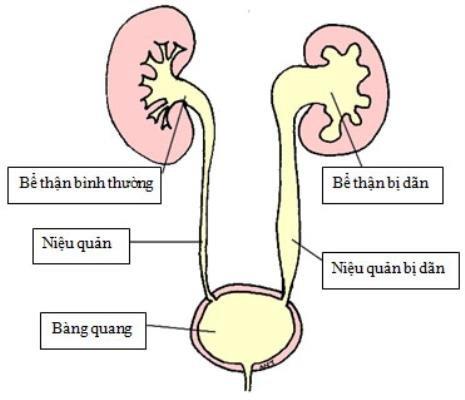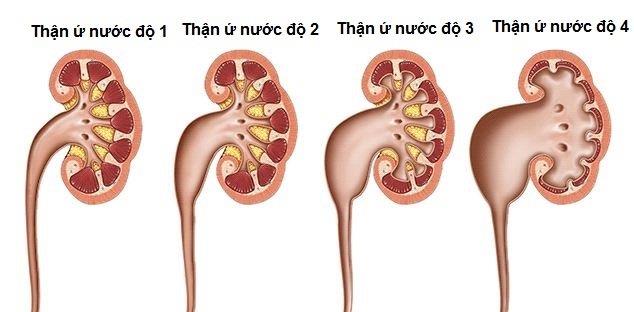Hydronephrosis: What you need to know

Hydronephrosis is the result of a blockage in the urinary tract in or out of the kidney. If not detected and treated promptly, the disease can cause very dangerous complications. The disease can cause impaired kidney function and damage the structure of kidney cells. To better understand the disease and treatment, please join SignsSymptomsList to learn useful information in the article below!
content
- 1. What is hydronephrosis?
- 2. Who often gets sick?
- 3. Signs
- 4. When do you need to see a doctor?
- 5. Grading
- 6. Cause
- 7. Is the disease dangerous?
- 8. How to treat hydronephrosis?
- 9. Advantages of laparoscopic surgery for hydronephrosis
- 10. Prevention
1. What is hydronephrosis?
Hydronephrosis is a form of kidney damage that manifests in the kidneys being dilated or swollen due to stagnant urine, blocked inside. This condition can occur on only one kidney or on both sides.
It causes damage to cell structures and impaired kidney function. These injuries can be minimized if treated early. However, if fluid retention persists for weeks or months, it can potentially cause symptoms to worsen, becoming chronic hydronephrosis (both kidneys are affected leading to kidney failure).
2. Who often gets sick?
Hydronephrosis can happen to anyone, at any age, including children and adults. You can limit your chances of getting the disease by minimizing your risk factors.
Factors that increase the risk of hydronephrosis include:
- Gender: Men are at higher risk than women.
- People who are suffering from kidney stones , uterine cancer, prostate enlargement ...
- Women with cervical cancer or those who are pregnant are at increased risk for hydronephrosis.
An illustration of the renal pelvis when it is dilated
3. Signs
3.1. Signs of acute hydronephrosis
- Low back pain or abdominal pain.
- Pain that begins in the lower back or flank and radiates to the groin.
- Accompanied by vomiting, nausea and sweating.
- The pain is intermittent, causing the patient to writhe or bend over because of the pain.
- There may be blood in the urine, painful urination.
3.2. Signs of chronic hydronephrosis
- The kidneys enlarge gradually over a long period of time and may not have any symptoms.
- When there are tumors in the pelvis or bladder causing compression, the tumor can grow silently and cause symptoms of kidney failure such as: fatigue, nausea and vomiting , disturbances in electrolytes sodium and potassium , calcium, arrhythmia.
- Urine tests can detect blood, bacteria that cause infections, or cancer cells.
- CT scan showed hydronephrosis and stones.
- Ultrasound showed hydronephrosis. The renal calyces are dilated, the kidney is enlarged.
4. When do you need to see a doctor?
See your doctor if you have hip pain or blood in your urine. You should also contact your doctor immediately if you notice drops of urine (not in a stream) while urinating or if you are unable to urinate. The location and medical condition can be different in many people. Always discuss with your doctor for the best diagnosis, treatment and management.
>> Kidney cancer is also a dangerous disease that needs attention. Learn more in the article Kidney cancer: What you need to know .
5. Grading
- Hydronephrosis stage 1: Grade 1 is the mildest grade. Grade 1 is only at a mild stage, so no treatment is needed but only monitoring and checking every 3 months. Based on the results of follow-up tests, the doctor will evaluate the function of the kidneys and analyze the urine or signs of disease to recommend appropriate treatment.
- Stage 2 hydronephrosis: When it turns to stage 2, signs such as 10 to 15 mm dilated glomeruli may appear. Patients often have symptoms of flank and hip pain throughout the day. May be accompanied by frequent urination 1.5-2 times more than usual.
- Stage 3: Hydronephrosis in grade 3 is the severe stage. The dilatation of the glomerulus has exceeded 15 mm in size. The renal calyx and renal pelvis are dilated into large cysts. This makes it very difficult for doctors to distinguish the renal pelvis from the calyx on CT scans. Patients often have symptoms of fatigue due to excessive water retention in the body. Immediate treatment is needed to avoid life-threatening complications.
- Hydronephrosis stage 4: This is the end-stage (most severe) hydronephrosis. The kidneys have been damaged to 75-90%. Patients often have symptoms such as swollen face and hands and feet, bloody urine, requiring urgent surgery.

Levels of hydronephrosis
6. Cause
Hydronephrosis is caused by a blockage in any part of the urinary tract.
6.1. Causes in the urinary tract
- In children, the blockage is usually due to a narrowing of the urethra (the urethra is the tube that carries urine from the bladder out of the body) or from a narrowing of the urethral opening (the tubes that carry urine from the kidneys to the bladder). ).
- For adults, the cause is often related to pre-existing conditions such as: kidney stones (causing urethral obstruction), bladder reflux, prostate enlargement, prostate cancer, bladder cancer. , uterus, ovaries and colon.
Kidney stones are considered one of the leading causes of hydronephrosis. Kidney stones cause ureteral obstruction. If it is a small stone, it moves from the kidney to the bladder easily. But if the stone is too big, it will block the ureter, causing urine to pool in the blockage. Meanwhile, the kidneys continue to filter out urine, but the ureters are blocked, unable to go down to the bladder, so the kidneys are waterlogged and enlarged.
On the other hand, if the urethra is narrow due to an infection or a previous incision to remove a kidney stone, it can also cause a blockage that causes the kidney to retain water. Bladder cancer , bladder stones, abnormal bladder neck contraction also block the passage of urine from the bladder to the urethra. As a result, urine collects from the bladder, causing the kidneys to become waterlogged.
6.2. External causes
If there is a tumor outside the urinary tract that is pressing on the ureter, it is also possible to block the flow of urine. Therefore, diseases such as cervical cancer, prostate cancer, uterine prolapse, multiple sclerosis, pregnant women, bladder dysfunction due to brain tumors... can all cause fluid retention. in the kidney.
In addition, it can also be caused by external influences from unhealthy and unhealthy eating habits and activities such as drinking a lot of alcohol, not sleeping enough, or overusing kidney tonics.

Unhealthy activities can lead to disease
7. Is the disease dangerous?
As is known, the kidney plays an important role in the human body. Every time the kidney is damaged, it will be accompanied by other symptoms that affect health. Hydronephrosis is an injured condition that causes swelling, edema, and dilation. It can cause dangerous complications if not treated promptly.
The severity of hydronephrosis depends on the condition of the blockage. If the disease is at level 1, the level of danger and damage to the kidneys can be completely improved, not dangerous to health. However, if not treated from the first stage, the disease will quickly progress to levels 3 and 4. At that time, the extent of damage will be up to 75-90%, accompanied by dangerous complications such as:
- The patient will have a sudden increase in blood pressure due to unstable blood gas regulation.
- When kidney function is impaired due to fluid retention, waste products cannot be transported out of the body. Over time, they accumulate in the kidneys causing kidney stones and kidney failure.
- Kidney infection is caused by damage to the wall and cortex of the kidney. Bacteria easily enter the kidney leading to infection.
- When the kidney is too large to hold water, the renal wall cannot withstand the pressure, which will lead to kidney rupture. This complication is very dangerous for the patient's life.
8. How to treat hydronephrosis?
Treatment is mainly based on the cause. First, it is necessary to identify the cause of the disease and resolve the blockage as soon as possible. This helps the kidneys recover quickly. In case of severe hydronephrosis or infection, the urine must be converted first. Only then will kidney function be reassessed before deciding to have nephrectomy.
8.1. Narrow junction of renal pelvis - ureter
For patients with ureteropelvic junction stenosis, depending on the degree of obstruction, there is an appropriate treatment. If the hydronephrosis is mild, the function of the kidney has not changed much, the treatment is usually conservative treatment without surgery. However, it is necessary to regularly monitor the condition of the disease.
When the kidneys are waterlogged, and the function is significantly reduced, surgery is indicated. Laparoscopic surgery is one of the best methods of treating renal-ureteral junction stenosis today.
8.2. Urinary stones
Urinary stones, including ureteral and pyelonephritis, are the most common causes of hydronephrosis. For small stones, kidney is not hydronephrosis or mild water retention can be treated medically with drugs. If the stone is large or symptomatic, causing severe pain in the hips and back, responds poorly to pain medications, or has impaired kidney function, surgery may be necessary.
The surgical methods of urolithiasis can be applied depending on the stone characteristics, including: extracorporeal lithotripsy, ureteroscopy laser lithotripsy, endoscopic percutaneous nephrolithiasis or endoscopic stone removal surgery.
9. Advantages of laparoscopic surgery for hydronephrosis
Today, most patients will be treated with minimally invasive surgical procedures (including intra-urinary endoscopy and laparoscopic or extraperitoneal surgery). The following are some advantages of the surgical method over the traditional open surgery method:
- There are no incisions or small incisions.
- Little blood loss.
- Little pain.
- Less damage to the abdominal organs.
- Fast recovery time.
- The length of hospital stay is reduced.
- Reasonable treatment costs.
10. Prevention
Once the cause is found, the rash can be prevented by:
- People with kidney stones should drink plenty of water every day to be able to remove the stones.
Kidney stone patients need to drink a lot of water
- For urinary tract infections: be monogamous, do not have promiscuous sex, regularly clean the genitals before and after sex, do not bathe or soak in polluted areas such as ponds and lakes. Women should maintain proper intimate hygiene. Only wash the private area from front to back, not from back to front... to prevent urinary tract infections upstream, narrowing the urinary tract and causing kidney retention.
SignsSymptomsList has provided you with basic information about hydronephrosis. If you have signs, symptoms or questions about the disease, please see your doctor for timely and timely advice and treatment.
Dr. Lu Thi Hong Van